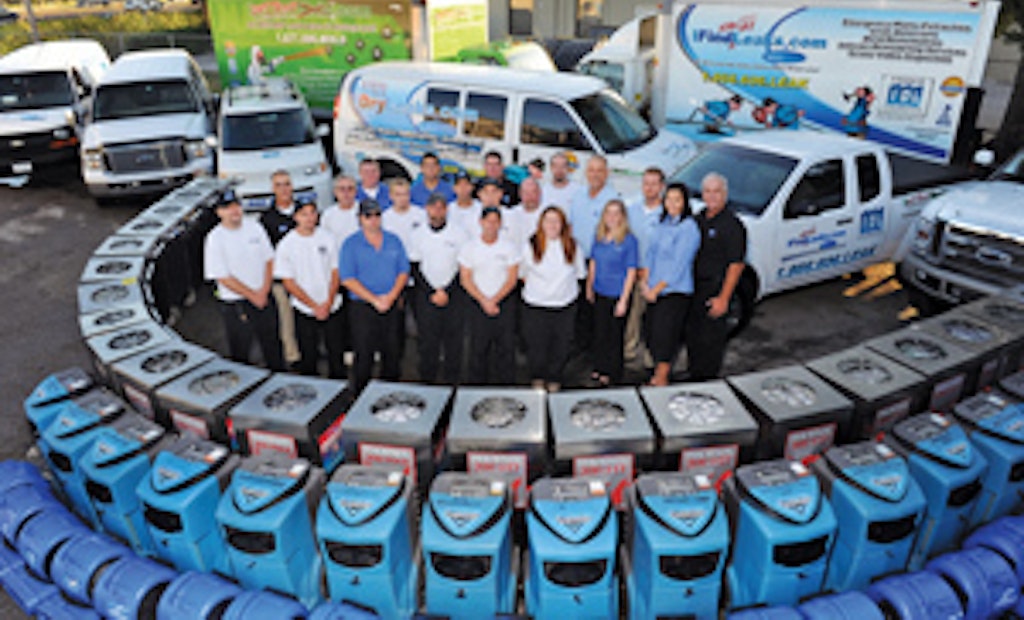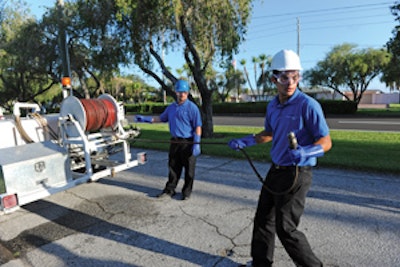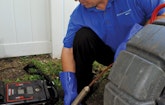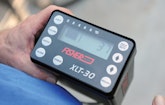
Interested in Location/Detection?
Get Location/Detection articles, news and videos right in your inbox! Sign up now.
Location/Detection + Get AlertsFlorida contractor John McCormick believes in sticking to a business plan. He founded the leak detection and jetting business I Find Leaks Inc. just six years ago. He now operates four successful brands that include emergency drying, mold removal and water damage reconstruction. His bottom line on business expansion: build logically on your core activity and avoid growth for growth’s sake.
McCormick left the high-tech sector eight years ago, just before the tech bubble burst.
“I could see that it was crashing and started to look at different trades that would be in high demand regardless of the economic climate,” he says. “I passed on electrical work because I didn’t like the idea of getting shocked and dismissed roofing, because there was no way I wanted to fall off a roof. I finally looked at plumbing and realized that there was a market for forensic plumbing – not run-of-the-mill toilets and pipes, but solving leak detection problems where you need to use your brain to solve tough problems.”
McCormick founded I Find Leaks in 2006 as a one-man operation, concentrating solely on property and premises water leaks for homeowners, business owners and property managers in the Clearwater area, on Florida’s west central coast.
“My friends thought the name was kind of stupid, but it’s worked out really well for marketing purposes,” he says. “It tells the customer exactly what the company does, without ambiguity.”
McCormick outfitted himself with a Fisher XLT series leak detector and a Gen-Ear water leak detection system from General Pipe Cleaners.
“About 90 percent of Florida leaks are in copper piping, primarily running under the concrete floor slab,” says McCormick, “The soil is acidic and the water is fairly hard so the lines are being worn down on the inside as well as the outside.”
While some companies use line tracers before leaks are pinpointed, McCormick insists on doing the reverse. The company finds leaks acoustically, then traces the lines to ensure they intersect with the leak location.
Defining the business
The company embarked on the venture with a strict definition of the services it would offer.
“That meant no plumbing repairs ever,” says McCormick. “We would recommend a reputable plumber but we would never want to be the company applying a jackhammer to the floor slab. Sticking to the core business was our recipe from the start.”
After the first year of operation, the company received requests for sewer camera inspections and purchased a Gen-Eye push camera from General Pipe Cleaners to scope lines.
“I also bought a RIDGID SeeSnake and, coming from the tech sector, I was quick to offer inspection recordings on DVD, burned from my laptop,” says McCormick.
In 2007, the company hired a second employee and added a jetter from Harben Inc.
The slate of offerings grew logically from the leak detection service. Typically, however, once the company had detected a leak and jetted out sewer lines, McCormick would be asked to recommend a contractor who could dry out the area to prevent mold formation, a major headache in Florida’s tropical climate. If the damage was severe, customers might also ask for a recommendation on a company that could rebuild the home after water-damaged building materials were removed.
“I had a lot of water-damage contractors offering me money to refer them, but I was having a hard time finding contractors I could trust,” says McCormick. “Some of them were taking a small job and turning it into a big job, removing too much drywall or taking out building components that didn’t need to be removed. In some cases, the insurance adjusters wouldn’t even examine the extent of the damage before authorizing the work.”
From leaks to drying
A lucky run at a local casino in 2008 changed the nature of the business. McCormick won $950 playing Texas hold ’em and decided to risk $50 of his winnings on a slot machine. His net winnings: $128,000.
“I invested the entire windfall in drying equipment so that I could get the premises of a water-logged building ready for the construction contractors, drying up the carpets and the floors,” he says. “That way I could make sure that the customer understood the actual extent of the damage before getting a water-damage remediation contractor to come in.”
The company’s drying arsenal includes a series of massive exhaust fans, heaters, and dehumidifiers.
To promote the new activity, the company added a second brand, I Dry Leaks, to its public face. That same year, McCormick hired a full-time office employee and three more field workers.
However, even after drying out a job site, McCormick says that he was still finding it difficult to recommend contractors to clients.
“A lot of them simply would never arrive, or worse, take a deposit and never show up again,” he says. “At the beginning of 2009, I brought in an employee with a general contractor’s license who could handle construction as well. He brought two employees with him and they specialized in installing flooring and drywall, painting and installing cabinetry. By the summer I had nine people on staff. Each step of the expansion was based on a legitimate business interest that built logically on the others. I wasn’t going to expand into an area that didn’t fit the business model, even if it looked lucrative at that moment. ”
Temporary setback
In July of that year, a Jet Ski accident sidelined McCormick’s expansion plans. “I fractured my sternum and was down for the count,” he recalls. “I was on pain meds and out of reality for about three months. When I was well enough to leave the hospital, I drove out to the office and found a padlock on the door. Every piece of equipment I owned was gone. It seems that some of the people I’d hired hadn’t looked out for the best interests of the business.”
Just as bad, former clients were being courted by a copycat business. McCormick simply gritted his teeth and started over, employing his fiancée in the office and starting again with two other employees.
“Surprisingly, with just a few employees, the business was running more efficiently than it had before,” says McCormick. “It’s hard to overstate how much more you can accomplish when you hire the right people. We were also more careful with accounting, so that money that was once disappearing down a rabbit hole was now being kept in the business. I took a pay cut, kept overhead to the bare minimum and re-invested all of the profits back into the business to rebuild our equipment stocks, and we did it relatively quickly.”
By 2010, the company had rebooted the dry-out side of the business and hired another five workers. McCormick also hired another employee with a contractor’s license, ushering in a new brand name: IDL Construction.
“Again, the core business model determines what kind of construction work we perform,” says McCormick. “It’s strictly streamlined – just cabinets, flooring, drywall, painting, and kitchen and bathroom cabinets. If we were asked to put a structural addition on a home we would turn that project down.”
Taking on mold
The company next embarked on another business venture that built on the success of the others: I Destroy Mold.
“Mold remediation is a job that involves high risks and high rewards,” says McCormick. “If you don’t do the job right and someone gets sick, you’re putting your reputation on the line and facing a possible lawsuit. Workers need to be licensed by the state of Florida to do the work and you need to hire workers who are committed to doing the job right.”
Mold spores exist in the atmosphere around us, just waiting for the right conditions to grow. The spores can grow in Florida homes under normal conditions even if the relative humidity exceeds 60 percent. A flooded Florida property provides enough moisture, humidity, darkness and warmth to spur accelerated growth. The most common spore found in the area is stachybotrys, a variety of black mold.
“The notion of contractors ‘killing mold’ is a bit misleading,” says McCormick. “Even if you kill a mold spore, the toxins left by the dead spore can create health problems, particularly in people who are allergic to them.”
A project begins with finding the source of the moisture and mold using infrared cameras by FLIR. Once the source of the mold has been established, the area is placed under containment using a plastic sheeting enclosure under negative air pressure. A HEPA filter fitted on the enclosure exhaust traps particles down to three microns in size. Dedicated dehumidifiers used only on mold jobs are placed inside the enclosure and likewise fitted with removable HEPA filters to trap mold spores.
Workers don specially designed mold suits – white coveralls with supplied air respirators. They also use handheld HEPA vacuums to remove mold.
“Going in, they look a lot like the Ghostbusters,” says McCormick. “They remove drywall, flooring, cabinets and any other mold-affected material. Of course, you can’t take the studs out of the house, so we sand down the surfaces. Once all of the material is removed we kill the remaining mold and clean the remaining surface area. People think you need to use harsh chemicals or bleach to kill mold, but we find it effective to use a mild detergent and a damp rag.”
By that year’s end, McCormick employed nine workers. By the end of 2011, the company employed 25.
The current business mix is about 85 percent residential, with the rest of the projects coming from the commercial sector. Jobs range from simple leak detection or jetting alone, to a full suite of drying, mold remediation and construction.
Much of the business is generated by word of mouth, but the company also uses sources such as Angie’s List to generate leads.
Web presence critical
The company operates four websites, one for each brand. Each site first offers information on the subject associated with its name, then expands to highlight the offerings of the other three brands.
“The websites are fun and professionally produced and probably inspire about 30 percent of our business,” says McCormick. “We know they’re effective because we get at least one call a day from people as far away as California, Utah or Michigan.”
That’s a good sign. McCormick has copyrighted all of the individual names and logos with an eye to franchising the business. For now, however, the company continues to expand throughout west central Florida, operating in Tampa and St. Petersburg and through the adjoining Hillsborough, Pinellas, Pasco, Polk and Manatee counties along the state’s west coast. This year, the company will open an office further south in Sarasota County. Next year, McCormick hopes to expand north.
“We’ve started and expanded so many divisions, that we need to be disciplined,” he says. “The important thing is that they all need to operate at 100 percent all of the time and we can only do that by sticking to the core business with no distractions. Leak detection is water damage is mold removal is interior remodeling. You can’t take your eyes off the core business.”










